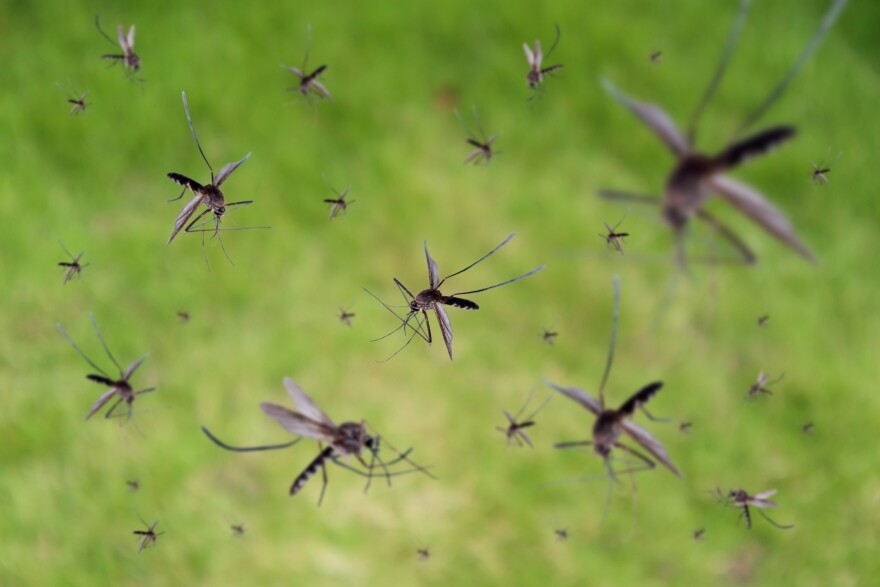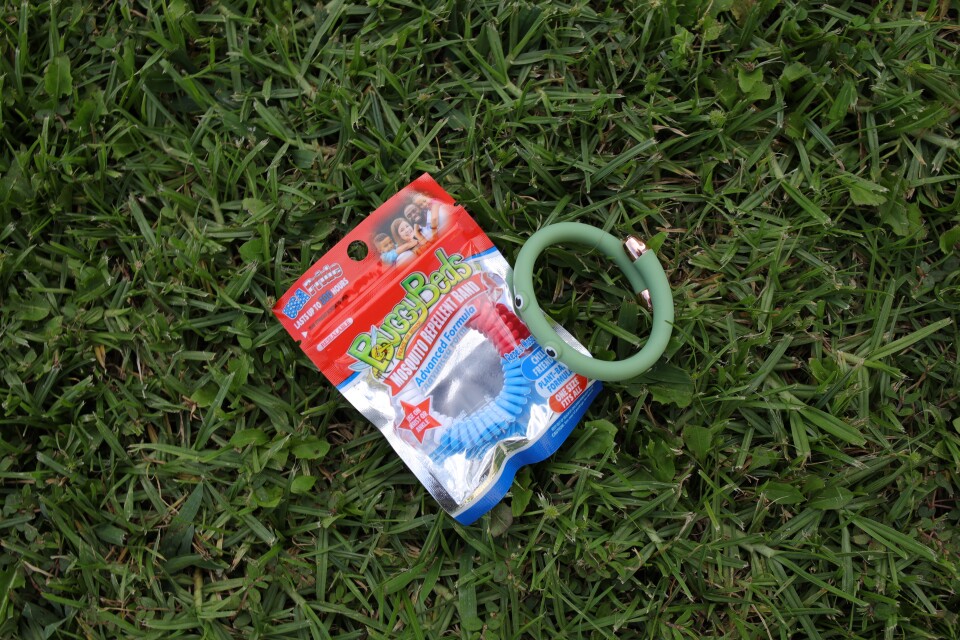Truth matters. Community matters. Your support makes both possible. LAist is one of the few places where news remains independent and free from political and corporate influence. Stand up for truth and for LAist. Make your tax-deductible donation now.
I Rolled Up My Pants And Sleeves To Test Mosquito Tech In The Wild. Did It Work?

For you, our dear LAist readers, I will go that extra mile. And that includes plonking myself down next to the Los Angeles River for a few days, in a backyard known for being Coachella for mosquitoes, to see if an array of mosquito repellent tech — and other not-so-tech repellents — could protect me from those pesky ankle biters.
(While summer may be over, the mosquito season, which has been particularly vicious this year, lasts through November).
Here are the results of my admittedly not-very-scientific test, but you can get a sense of what worked well, and what didn’t work so well, over the days I spent in my colleague’s backyard. (She says she gets bit in her dirt backyard all the time.)
Starting with the ‘techiest’ tests
On day one, I knew I hit the jackpot. In the yard, right away, I saw a crowd of bugs, including mosquitoes, among the plants. Would they be scared off by Big Repellent? Or would I be reduced to a chewed up wreck of itchy pink blotches?
There are a few smaller mosquito tech companies, but the main one cornering the market on fancy tech gear is Thermacell, which makes dozens of products.
(Disclosure: I did ask Thermacell to send me a couple of products to try, but we don’t earn any commission on this. I also took steps to ensure fairness and accuracy in evaluating the tools, such as testing separately and over multiple days.)
One of the first items for my test was Thermacell’s MR450, a hand-held mosquito repellent device that looks like one of those retail inventory scanners. It’s designed for you to use while moving, mostly scent free, with 15 feet of protection.
It works by heating a small blue mat on a grill that disperses the main ingredient, EPA-approved insecticide allethrin, into the air. Instead of a battery, it runs by burning a tiny fuel cell that heats up the mat.

I powered it up, sat at a picnic table and worked on my laptop, waiting for a mosquito to make me their meal.
Product Information
The product: Thermacell MR450
The main ingredient: Allethrin
Cost: $34.99
It immediately seemed to work — even though I could see mosquitoes right by me, I wasn’t getting bit.
I felt smug and safe… until about 20 minutes in, when I felt that annoying itch, and a red hive formed on my arm. Over the next few hours, I got about three bites, which, I admit, was far less than I thought I’d get.
The verdict: For a portable mosquito tool, it’s useful to a certain degree. Wind can alter the effectiveness because the repellent is in the air. The grill got a little too warm for my liking, and the ignition can be finicky, too. It’s clunky to carry around, but you can easily clip it onto a bag (just face the grill away from you). Both fuel and repellent will need to be replaced. Outdoor use only.
The next day, I returned to the backyard to try the next device on my list — Thermacell's E55 and E90. These are table devices that work like a diffuser and disperse another insecticide, metofluthrin, as the main ingredient. You just place it on a table near you and get 20 feet of protection. It’s rechargeable via a USB cable, and battery life is the main difference between the two models.

Product Information
The table devices work by putting a small repellent container into the charged device and allowing it to warm up. A tiny mist comes out without a noise or smell.
I did the same thing as before and exposed my ankles and shoulders for mosquitoes to munch on while I worked on my laptop. And despite seeing many mosquitos, I only got three bites over a few hours.
The verdict: Easy to set it and forget it. The effectiveness is still susceptible to wind, but that was less of an issue while I was sitting still. Only the repellent will need to be replaced. Outdoor use only.
Mosquito bracelets
I purchased the first bracelet from Switch Catch on Amazon. There are likely hundreds of versions of this online, but this was a “kids” version that uses plant-based oils like citronella and eucalyptus to repel insects.
The band is simple: You put a very tiny stick of the oils into both ends and screw the cap on. Unlike the Thermacell tools, this natural repellent can be used indoors and outdoors.

The other bracelet I tried was a truly no-tech one. BuggyBeds’ repellent band can be used straight out the bag, even as a hair scrunchie, and it’s also plant-based.
The drawback of bands like these are that the citronella scent can be quite strong, and there’s a concern that natural repellents aren’t nearly as effective as other common mosquito repellent ingredients. These are also personal repellents, so there’s not an extended radius of protection to keep those around you from being bit.
Product Information
The product: Swift Catch Mosquito Repellent Band
The main ingredient: Citronella oil, blue and lemon eucalyptus oils
Cost: $9.99
The product: BuggyBeds Mosquito Repellent Band
The main ingredient: Citronella oil, geraniol, cinnamon oil, lemongrass oil, clove oil, peppermint oil
Cost: $13.99 (pack of 12)
I sat at the picnic table again and watched for bites. And at the end of a few hours — I had none. Nothing, nada. Eureka, right? Except I realized there was a catch in my testing methods. The day I used the bracelets, it was cooler, and mosquitoes tend to be more active in warmer temperatures. So was the lack of bites due to the bracelets? I’m not convinced. But maybe it was. Hard to tell.
The verdict: Bands are easy for anyone to use but they have a strong scent. Swift Catch’s bracelet will need refills. BuggyBeds is one-time use but claims that bands last up to 300 hours. They use plant-based repellents, which may not work as well as other repellents. Can be used indoor and outdoors.
Classic sprays and lotions
So how does all of these new-ish products compare to the traditional stuff — good ‘ole spray and lotion? I went back for a fourth day (yes, I was committed to the task) to see.
I put on Sawyer’s picaridin lotion, Jungle Juice deet spray and Ben’s deet wipes, plus a natural spray from All Terrain called Herbal Armor with a largely soybean and citronella oil base.
And I made sure to use them on different parts of my body and washed them off in between.

Luckily this day was as hot as the first two days when I tested the tech devices, so I felt it was a fair comparison. So after two hours, covered in lotion, what happened?
Well … no bites. Not even after mosquitos visibly landed on me. (I was waiting for the itch, but it never came). I really was quite surprised.
PRODUCT INFORMATION
The product: Ben's 30 Tick & Insect Repellent Wipes
The main ingredient: Deet (30%)
Cost: $6.79
The product: Sawyer Jungle Juice 100 Insect Repellent
The main ingredient: Deet (98.8%)
Cost: $9.95
The product: Sawyer Picaridin Insect Repellent Lotion
The main ingredient: Picaridin
Cost: $9.95
The product: All Terrain Herbal Armor Natural Insect Repellent
The main ingredients: Soybean and citronella oils
Cost: $12.99
The picaridin and deet gave me the strongest protection. The jury is out for me on whether Herbal Armor made much of a difference.
The verdict: Deet and picaridin are well-documented being effective, but keep in mind that some deet products can have a strong scent. And compared to the tech, there were drawbacks: the deet was greasy to put on and had a strong smell, as did the picaridin. But the latter was a lotion that soaked in pretty smoothly and wasn’t as greasy.
Overall conclusion
My overall conclusion from my four days of testing? One, is that the itching I had from about six bites was worth it to give you some useful information. Second, is that I think all the products had benefits and drawbacks, and that I’d probably use both the lotion and tech in different situations and contexts, like if I’m doing something quick outside or deep in the hills camping.
So for those tech devotees out there — it wasn’t a slam dunk. It just goes to show that traditional stuff may not be replaced just yet.
What studies say about repellents
A 2017 study out of New Mexico State University found that spray-on repellent with deet or PMD (a natural repellent compound) had the highest efficacy compared to other main ingredients tested, while wearable devices with metofluthrin (the main ingredient in Thermacell’s table device) significantly reduced the number of mosquitoes attracted. They found that citronella had no effect.
Likewise, a 2019 study from the Innovative Vector Control Consortium in the United Kingdom found that metofluthrin and allethrin (the main ingredient in Thermacell’s handheld device) in airborne repellents are effective against Culex and Aedes aegypti mosquitoes, which are commonly found in Southern California.
The results may vary on the effectiveness of certain types of repellents, so always check with your doctor about what’s best. Some experts believe that natural repellents aren’t worth trying, but concentration, environment and ingredients could change that.
How to keep pets from being bitten
Most of the repellants that are OK for humans can harm pets, and thick fur doesn't protect them from mosquito bites.
"Mosquitoes don't care how much hair there is," said veterinarian David Clark, director of the Pet Health Center at the Western University of Health Sciences in Pomona. "They're small enough, they just get down in there and get breakfast."
Mosquitoes in the U.S. can carry heartworms, which are parasites that enter an animal's bloodstream though mosquito bites and live in the heart. They can kill dogs and cats.
Dog owners have multiple medications to chose from, including chewable tablets and topical medications that can be given to the animal at home, and injections administered annually at veterinary clinic. There is no treatment for heartworms in cats once they are infected, so prevention is the only means of protecting them from the disease.
Clark said products containing permethrin act as a mosquito repellant and kill fleas and ticks when used as directed on dogs, but too much can be toxic. The products can 't be used at all on cats.
Veterinarians recommend topical monthly medications for cats, such as Revolution and Advantage Multi.
He said his best advice is to keep mosquitoes out of your home and yard by dumping standing water where the insects breed and putting up well-fitting screens on windows and doors.
LAist reporter Jackie Fortier contributed to this report.
Updated June 3, 2024 at 2:03 PM PDT
This story has been updated with information about how pet owners can protect dogs and cats from mosquito bites.













